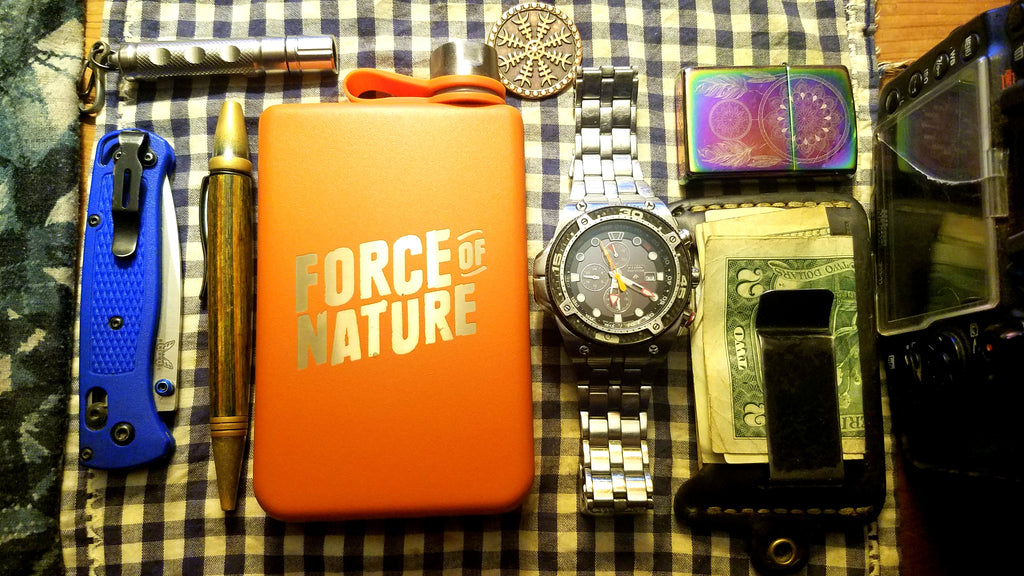December 02, 2020
I'm going to preface this piece by saying some methods of preventing cold weather injuries and surviving subfreezing temperatures can be hazardous to ones health if proper precautions for the specific methods aren't taken. However cold weather, and cold weather injuries, can be just as deadly. Neither should be taken lightly or approached in a cavalier manner. Having experienced both hypothermia and frostbite myself, and having seen up close people who had died of hypothermia, this is something I can attest to personally.

In some circles, a flask of ones favorite flammable libation is affectionately – albeit a bit sarcastically – referred to as “antifreeze” as a time-honored winter tradition. The reason for this isn't because consuming it will keep one from freezing to death in extended exposure to cold. In fact it's actually infamous for having the exact opposite effect, hence the note of ironic sarcasm in the nickname. Rather it's because a shot or two of spirits can temporarily subdue the biting of the cold, as a mechanism for coping with it for short periods of time. Such as going out to fetch firewood, or especially when going to the out house back in the day. For me, here in the modern world, it comes in handy when I'm doing winter photo shoots, because gloves are not conducive to manual photography, and when I'm stuck out in the cold waiting on an Uber. It can however help prevent one from freezing to death in another way, but that can be a bit extreme, so there's more on that later in the article.

Our bodies lose heat three in ways; radiation conduction and convection. That is to say we radiate heat no matter what, we conduct heat into any cold objects our bodies come in contact with, and cold winds convey body heat away from us. And in a cold environment, the fewer of these mechanisms that are mitigated the greater the chance of injury or death.
Proper cold weather clothing is wonderful because it addresses all of these issues by trapping our radiated heat, shielding our skin from wind, and insulating our bodies from direct contact with cold surfaces. But sometimes things happen, and we find ourselves out in the cold unexpectedly. If the quick trip to the store doesn't go as planned, and we're not really dressed for time out in the cold, having hand foot and body warmers in our vehicle can be a saving grace. Using their radiant heat to augment our own, under whatever clothing we are wearing, can mean the difference between life and death.

I don't smoke cigarettes, but I've carried a Zippo lighter ever since my Dad gave me one for Christmas at age 10, and I'll continue to carry one for as long as it's an option. Partially out of nostalgia and remembering times with my Dad, and partly because I much prefer them over butane lighters for starting fires under the windy conditions on coasts and on the shores of rivers where the wind travels unobstructed. But also because in a pinch they can be; struck, lit, and left sat burning to ignite damp fuel or produce radiant heat in a sheltered but ventilated environment in an emergency.

These days I have a better option to leave sat burning for heat if the need arises. The Candle Tins from Exotac are pretty cool pieces of kit. The ones with the larger wicks produce more heat for cooking, or for boiling water quicker, but they also produce more smoke. So I prefer the smaller wicks as an emergency heating option. They last longer when burning just one wick at a time, but obviously they produce more heat quicker when all three are lit. Just bear in mind the metal sides nearest the flame(s) can get very hot. It will melt plastic or cause burn injuries to bare skin. Once lit they should be kept away from melt-able surfaces, and the sides near the burning wicks shouldn't be touched with bare skin again until extinguished and allowed to cool.

Wind is a force multiplier for cold. Continual exposure to cold winds will convey more of our natural body heat away from us quicker than we would lose it just sitting on a cold object out of the wind. Thus the significance of the “wind chill factor”. In nature animals don't have the advancements in technology we benefit from, yet they still routinely survive the cold windy nights of winter. In some instances deer do this by exploiting tall fields of grass, and doing this has three benefits. The hollow stalks of grass they lay on mitigate conduction of heat by trapping warm air and insulating their bodies from the cold ground. The surrounding wall of grass shields them from the wind, minimizing the amount of heat they lose through convection, as well as creating a more confined space that slows the travel of their radiated heat away from them. Should the madness that is 2020 find you – for whatever reason – ill-prepared in an unfamiliar environment one cold night, the fields of clumps of ornamental grasses used in urban landscaping could benefit you in much the same way.

Rain is another force multiplier for the negative effects of cold. It cools our bodies on contact, and it fills the voids of warm air in any clothing it saturates with cold liquid, both robbing us of their insulating effect and stealing our heat through constantly renewed conduction for as long as we are exposed to it. In nature animals use various natural elements for shelter; caves ,shelter rocks, and the leaning boles of trees with dense foliage. In urbanized environments we typically have; doorways, awnings, and stairwells like the one above to serve as our caves and outcroppings. Yet in a pinch some ornamental evergreens with dense foliage like Holly, Magnolia, and Fir can be very helpful as well. Because just staying dry on a cold wet night, even if the temps will only drops into the upper 40s, will offer a better chance of a good outcome than spending the night cold and wet. Especially if it's worsened by a soaking from a vehicle hitting a large puddle, as the truck in the image just did.

As for how the flask of alcohol can serve as an anti-freezing agent, it is via the alcohol's flammability. Even 80 proof (40%) alcohol will burn, and the higher the proof the easier it is to ignite and the hotter it burns. In fact this warning is exactly what that big red rectangle at the bottom of the label on the Golden Grain bottle is all about, and that at this potency, 190 proof, it is meant for mixing not drinking straight. Which means that it's not only good for spiking bowls of holiday punch, but can be also be used as an accelerant to start a fire, or as fuel for an improvised stove as well. All you really need for the stove is a non-flammable container to serve as a fire box.
The things to bear in mind here are; clear alcohol burns with a very hot and nearly invisible pale blue flame. Without some other element(s) to contaminate it – in this case the paint on the bottle cap – the flame is very hard hard to see in the light. As you can see with the flame burning in the condiment container. And flowing invisible flames can be very dangerous. Much care and proper precautions should be taken if the situation has deteriorated to the point of using this method to avoid injury or stay alive. As a point of reference, the very small amount of Golden Grain in the bottle cap burned for 3 minutes and 27 seconds.
Cold weather can be quite deadly, and the colder the more deadly. In the winter of 1982/83 I watched a doctor meticulously remove gangrenous flesh from my feet and hands. Where frost bite had been severe, and had gone untreated due to circumstances beyond my control. One of the harsh lessons learned that day was that when the cold quits hurting it is not a good sign, but rather it's a very bad one. And another was that cold temps should never be taken lightly, and we humans surviving an ice age by primitive means was a far more impressive feat than I had previously realized in my studies of early man. I developed a whole new respect for our ancestors that day, and the animals of the wild world I have been studying ever since.
December 10, 2020
Thank you Douglas, always good hearing from you! I’m glad you enjoyed it!
Thank you Cindy!! I’m glad you liked it!!
December 04, 2020
Another great read 👍🏼
December 04, 2020
Great article!! I enjoyed reading it!
Comments will be approved before showing up.
Frequently Asked Questions
Product Warranty Information
Returns & Exchanges
Shipping Policy
Terms & Conditions
Privacy Policy
Contact Us
Search
Sign up to get the latest on sales, new releases and more…
Fiddleback Forge
5405 Buford Hwy Ste 480
District Leather Bldg
Norcross, GA 30071
© 2025 Fiddleback Forge.
Fiddleback Forge brand name and Logo are registered trademarks of Fiddleback Forge, Inc. All rights reserved.

Brian Griffin
December 10, 2020
Thank you Douglas! I’m glad you liked it, and like them!
Thank you Cindy! I’m glad you liked it!